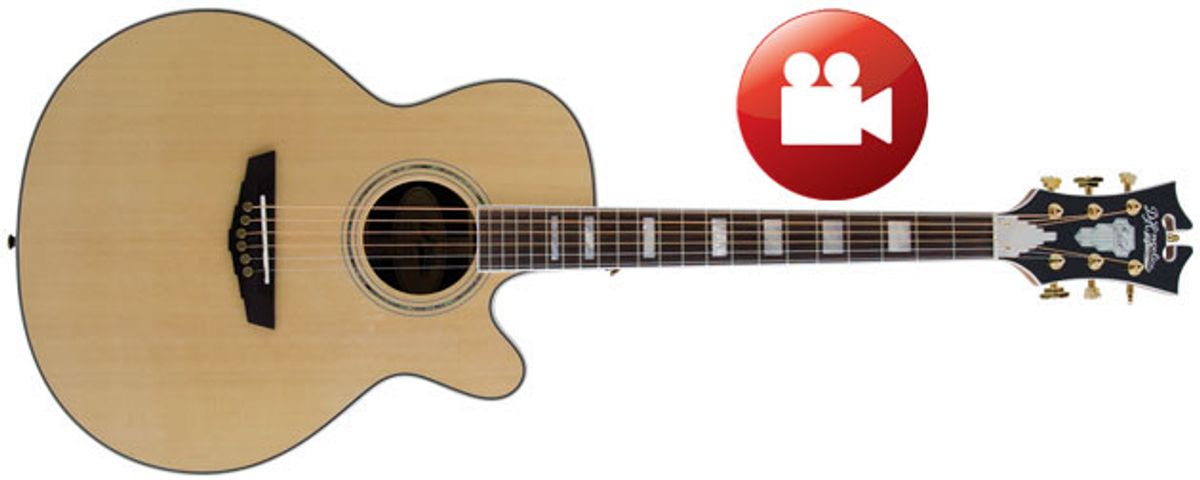D’Angelico’s foray into flattops yields a stylish grand auditorium model.
At last winter’s NAMM show in Anaheim, California, D’Angelico Guitars unveiled a line of steel-string flattop acoustics with names like Gramercy, Mercer, Lexington, and Madison. These are, of course, references to locales in Manhattan, where the legendary luthier John D’Angelico built the finest archtops to order from the 1930s until his death in 1964.
With its onboard Fishman electronics, the Asia-built Gramercy is a very different guitar from those classic original archtops. And apart from D’Angelico’s iconic art deco headstock, it doesn’t really resemble anything that the master guitarmaker ever built. But after I put the Gramercy through its paces (and in spite of the very high expectations that come along with the D’Angelico name), I found it to be an agreeable guitar in its own right.
Fancy Meets Subdued
The grand auditorium-sized Gramercy is made from a nice selection of all-solid tonewoods. The top is Sitka spruce with scalloped-X bracing, and the back and sides are rosewood. The mahogany neck is fitted with a rosewood fretboard, and the bridge is rosewood too.
Freddie Green-inspired comping.
At five pounds, nine ounces, you can’t say the Gramercy is lightweight, but the craftsmanship is very good. The polyurethane gloss finish is free from orange peel and other cosmetic defects, and all of the binding is tight and flush with the body. The frets are cleanly dressed and smooth at their edges. The bone nut and saddle are immaculately cut. Inside, everything appears tidy too. The bracing and kerfing are free from traces of excess glue and rough unfinished surfaces.
The Gramercy is available in five different finishes: natural, vintage sunburst, cherry sunburst, black, or a very contemporary grey black. Our review model came in natural, which best showcases the soundboard’s fine-grained, cream-colored spruce and the dark-chocolate, quartersawn rosewood on the back and sides—a very nice set of boards. The guitar is handsome, but to some players the trademark headstock, with its ornate inlay work, mirrored truss-rod cover, pointed scroll, and chevron-shaped machine heads, might look out of place on an otherwise restrained and traditionally appointed flattop.
Clear Up Top
The Gramercy has a C-shaped neck with a slim profile that’s super comfortable and familiar—especially for players who typically play electric. But the action on our review model was higher than optimal, making it a strain to play barre chords for extended periods and inhibiting fast picked single-note lines. This isn’t necessarily a deal breaker. A good guitar tech could certainly lower the action. But it’s hard not to expect a better setup for a guitar that’s nearly a thousand bucks.
Ratings
Pros:
Nicely made, versatile, acoustic-electric. Solid woods.
Cons:
Setup could be better. Design elements seem mismatched.
Tones:
Playability:
Build/Design:
Value:
Street:
$999
D’Angelico Gramercy SG200 Grand Auditorium
dangelicoguitars.com
Acoustically, the Gramercy lacks some of the resonance and liveliness of a fine grand concert model, and the bass register is a tad underwhelming. But the Gramercy does deliver impressively present mids and clear treble tones. Harmonically speaking, the note-to-note definition and separation are good. And in this context, at least, the buzz-free higher action pays bonus dividends.
Any sonic shortcomings are often compensated for by a guitar’s versatility, and in that regard the Gramercy responds equally well to all types of strumming approaches, from boom-chuck to crisp Freddie Green-inspired comping. When fingerpicking—in both standard and altered tunings—the high action made me feel less nimble, but single-note lines had good presence and definition.
Comprising an under-saddle pickup and onboard preamp, the Gramercy’s Fishman INK-4 electronics package is a nice fit for the guitar. Mounted to the upper bass-side bout, the low-profile preamp is less obtrusive than most. Plugged into a Fender Acoustasonic, the Fishman system sounds terrific, very natural and free of extraneous noise. The bass, middle, and treble controls offer more than enough tonal flexibility for any situation, while the brilliance control adds zing to the guitar’s already sparkling personality. The INK-4’s built-in tuner, which turns green when the string is at pitch, is very readable.
The Verdict
Purists and collectors might not have time for D’Angelico apart from an archtop made on the Lower East Side. But those without such allegiances will find a nice modern flattop in the Gramercy—a guitar that can be played in a variety of styles and stands stage-ready, thanks to the well-matched Fishman electronics. For the price, it does lack some of the complexity and bass richness you’d expect from a good grand auditorium—a body shape often chosen for its strength in those regards. But the ringing high-mids mean it can sit nicely in contemporary studio settings. If you like a little touch of Downtown glam with your otherwise functional flattop, the Gramercy is a great place to start.
Watch the Review Demo:

